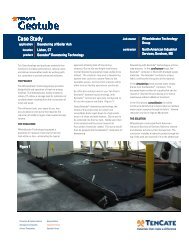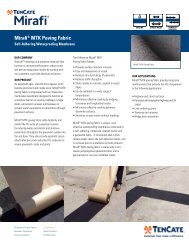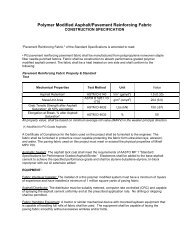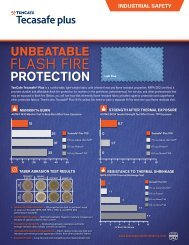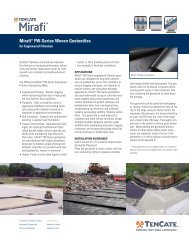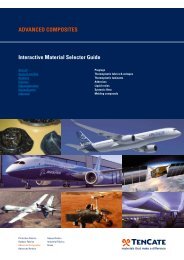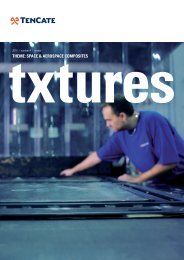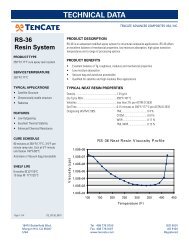end-user marketing geosynthetics / advanced composites - TenCate
end-user marketing geosynthetics / advanced composites - TenCate
end-user marketing geosynthetics / advanced composites - TenCate
Create successful ePaper yourself
Turn your PDF publications into a flip-book with our unique Google optimized e-Paper software.
During the celebration of <strong>TenCate</strong>’s three<br />
hun dredth anniversary in 2004 President and CEO<br />
Loek de Vries presented his vision on the future<br />
of textiles, the Twente manufacturing industry<br />
and the role that open innovation played in this.<br />
To that <strong>end</strong> he outlined his image of Twente as<br />
Materials Valley. ‘At a regional level there is a<br />
great need for increased cooperation between<br />
the industrial sector and knowledge institutes,<br />
he told his audience. ‘As the largest private<br />
employer in Twente, <strong>TenCate</strong> has taken the<br />
initiative that has resulted in the launch of<br />
Materials Valley to ‘bring about alliances<br />
between companies and to tighten links<br />
with the University of Twente, Saxion<br />
University and regional education centres.<br />
In addition, <strong>TenCate</strong> has invited companies<br />
from other sectors to join forces in applying<br />
their knowledge, skills and experience.’<br />
Framework for innovation<br />
As early as 2004 there was a need at national<br />
level for a framework to promote innovation.<br />
In the opinion of Loek de Vries it was up to<br />
national and regional administrators to create<br />
the preconditions to make innovative solutions<br />
possible. ‘Ambitious plans demand not only a<br />
challenging climate for research and education,<br />
but also financial participation by government<br />
to cover the risks inherent in innovation and<br />
cooperation between industry and science.’<br />
In his view, it is the research & development,<br />
the level of education and the creativity that are<br />
available that form the input for the innovation<br />
strength of a region. The output is made up of the<br />
innovations resulting from it. ‘This is very often<br />
measured in the number of patents. The interplay<br />
of forces and cooperation within the innovation<br />
triangle, consisting of companies, administrators<br />
and knowledge institutes, will determine<br />
whether you achieve valorization - an increase<br />
in value in fundamental and applied research in<br />
industry. This requires face-to-face contact and a<br />
functional relationship between inventors, manufacturers<br />
and suppliers to get the partnership off<br />
the ground. OICAM fulfils its own role in this.’’<br />
Linking of technologies<br />
In essence, Twente is a materials area, a<br />
Materials Valley. Approximately 28% of<br />
companies are to be found in this high-grade<br />
manufacturing industry. ‘We should not renounce<br />
our roots, however. <strong>TenCate</strong> is a textile company,<br />
and it is in that field that we have knowledge<br />
and skills. We must link up chemical technology,<br />
textile technology, material technology and<br />
nanotechnology and embed these disciplines in<br />
a foundation of applied and industrial research.<br />
That is what <strong>TenCate</strong> does. Together with other<br />
companies this produces innovative spin-offs.<br />
Such a supra-regional approach will really put the<br />
region of Twente on the map as Materials Valley.’<br />
Loek de Vries emphasizes the importance<br />
of cooperation between the four elements,<br />
consisting of companies, public sector bodies and<br />
educational and research institutes, observing<br />
that in companies there is always a sense of<br />
urgency. ‘There is greater haste, more drive.<br />
Innovation cannot be imposed from above.<br />
The role of government must be supportive<br />
and enterprising. True innovations always<br />
start small and need to be given structure.’<br />
Innovation route: five clusters<br />
The above four elements have defined five<br />
clusters for the Innovationroute Twente:<br />
Nutrition, Care, Megatronics, Materials and<br />
Construction. The first three are demand-driven,<br />
the remaining two, supply-driven. ‘What you now<br />
have to do is look for common ground: where<br />
does supply support demand? What for example<br />
can the Materials cluster do to help the Care<br />
cluster? It is from these sorts of questions that<br />
innovation springs. We must strive to achieve<br />
chain-knowledge structuring and remain focused.<br />
This sometimes demands bold options: good<br />
strategy makes some customers unhappy.’<br />
On the interface between the supply and<br />
demand of the clusters, collaboration will be<br />
possible by combining fundamental, applied<br />
and industrial research. The University of<br />
Twente, Saxion University and industry are<br />
working together on this Regional Technological<br />
Roadmap. ‘Scientists and regional and provincial<br />
administrators monitor the connections and<br />
give or withhold the go-ahead. This is the right<br />
way to sp<strong>end</strong> innovation budgets. If you aim<br />
to create strength, you must not give money<br />
to the clusters separately, without any coherence.<br />
It is vital to achieve unity and structure.<br />
Ultimately, it is the government that has final<br />
responsibility for allocating innovation budgets.’<br />
Inventions and innovations<br />
‘Our entire company is R&D-driven’, concluded<br />
Loek de Vries. ‘At least five per cent of our<br />
budget is spent on research and development.<br />
<strong>TenCate</strong> is without doubt the worldwide leader<br />
when it comes to the number of patents filed<br />
in the textile market. But not every invention is<br />
an innovation; an invention does not become an<br />
innovation until it is actually used. In general, it<br />
appears that companies do not use 95% of all<br />
inventions. “Large companies have five to ten<br />
per cent of true innovations and these are thus<br />
the real cash cows”, said Professor of Urban<br />
Economics, Frank van Oort in the 2010Twente<br />
Index. The same applies to <strong>TenCate</strong>. You evolve<br />
from invention to innovation, from prototype to<br />
product and then it must also be reproducible<br />
and sustainable. I regard it as a great asset<br />
that, with the support of Peter den Oudsten<br />
as Chair of the Region of Twente, a centre like<br />
OICAM will enable us now to really get down<br />
to work on innovation. Let’s make an energetic<br />
start and above all, respect each other’s roles.’<br />
23




